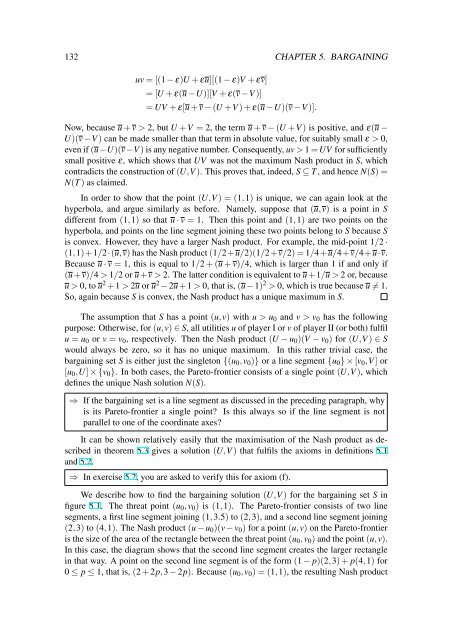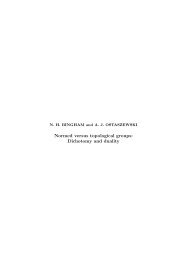Game Theory Basics - Department of Mathematics
Game Theory Basics - Department of Mathematics
Game Theory Basics - Department of Mathematics
You also want an ePaper? Increase the reach of your titles
YUMPU automatically turns print PDFs into web optimized ePapers that Google loves.
132 CHAPTER 5. BARGAININGuv = [(1 − ε)U + εu][(1 − ε)V + εv]= [U + ε(u −U)][V + ε(v −V )]= UV + ε[u + v − (U +V ) + ε(u −U)(v −V )].Now, because u + v > 2, but U +V = 2, the term u + v − (U +V ) is positive, and ε(u −U)(v −V ) can be made smaller than that term in absolute value, for suitably small ε > 0,even if (u−U)(v−V ) is any negative number. Consequently, uv > 1 =UV for sufficientlysmall positive ε, which shows that UV was not the maximum Nash product in S, whichcontradicts the construction <strong>of</strong> (U,V ). This proves that, indeed, S ⊆ T , and hence N(S) =N(T ) as claimed.In order to show that the point (U,V ) = (1,1) is unique, we can again look at thehyperbola, and argue similarly as before. Namely, suppose that (u,v) is a point in Sdifferent from (1,1) so that u · v = 1. Then this point and (1,1) are two points on thehyperbola, and points on the line segment joining these two points belong to S because Sis convex. However, they have a larger Nash product. For example, the mid-point 1/2 ·(1,1)+1/2·(u,v) has the Nash product (1/2+u/2)(1/2+v/2) = 1/4+u/4+v/4+u·v.Because u · v = 1, this is equal to 1/2 + (u + v)/4, which is larger than 1 if and only if(u+v)/4 > 1/2 or u+v > 2. The latter condition is equivalent to u+1/u > 2 or, becauseu > 0, to u 2 +1 > 2u or u 2 −2u+1 > 0, that is, (u−1) 2 > 0, which is true because u ≠ 1.So, again because S is convex, the Nash product has a unique maximum in S.The assumption that S has a point (u,v) with u > u 0 and v > v 0 has the followingpurpose: Otherwise, for (u,v) ∈ S, all utilities u <strong>of</strong> player I or v <strong>of</strong> player II (or both) fulfilu = u 0 or v = v 0 , respectively. Then the Nash product (U − u 0 )(V − v 0 ) for (U,V ) ∈ Swould always be zero, so it has no unique maximum. In this rather trivial case, thebargaining set S is either just the singleton {(u 0 ,v 0 )} or a line segment {u 0 } × [v 0 ,V ] or[u 0 ,U] × {v 0 }. In both cases, the Pareto-frontier consists <strong>of</strong> a single point (U,V ), whichdefines the unique Nash solution N(S).⇒ If the bargaining set is a line segment as discussed in the preceding paragraph, whyis its Pareto-frontier a single point? Is this always so if the line segment is notparallel to one <strong>of</strong> the coordinate axes?It can be shown relatively easily that the maximisation <strong>of</strong> the Nash product as describedin theorem 5.3 gives a solution (U,V ) that fulfils the axioms in definitions 5.1and 5.2.⇒ In exercise 5.2, you are asked to verify this for axiom (f).We describe how to find the bargaining solution (U,V ) for the bargaining set S infigure 5.1. The threat point (u 0 ,v 0 ) is (1,1). The Pareto-frontier consists <strong>of</strong> two linesegments, a first line segment joining (1,3.5) to (2,3), and a second line segment joining(2,3) to (4,1). The Nash product (u − u 0 )(v − v 0 ) for a point (u,v) on the Pareto-frontieris the size <strong>of</strong> the area <strong>of</strong> the rectangle between the threat point (u 0 ,v 0 ) and the point (u,v).In this case, the diagram shows that the second line segment creates the larger rectanglein that way. A point on the second line segment is <strong>of</strong> the form (1 − p)(2,3) + p(4,1) for0 ≤ p ≤ 1, that is, (2 + 2p,3 − 2p). Because (u 0 ,v 0 ) = (1,1), the resulting Nash product
















